
AN INTERVIEW Islamic Calligraphy Art by Ayman Hassan
Jul 19, 2017 Interview
This article is a part of the project 'Promotion of the Ottoman Cultural Heritage of Bosnia and Turkey' which is organized by Monolit, Association for Promoting Islamic Arts and supported by the Republic of Turkey (YTB - T.C. BAŞBAKANLIK Yurtdışı Türkler ve Akraba Topluluklar Başkanlığı / Prime Ministry, Presidency for Turks Abroad and Related Communities).
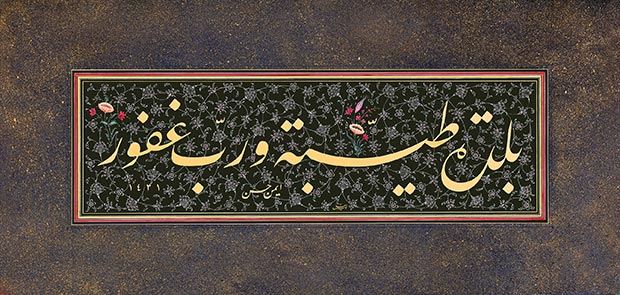 Ayman Hassan, calligraphy / Courtesy of the Artist
Ayman Hassan, calligraphy / Courtesy of the Artist
I started tasting the beauty of Arabic alphabet written in beautiful calligraphy before I even learn how to read them. That was in my pre-school years. My elder brother had been trying to learn calligraphy and I used to watch him practicing with a lot of admiration. However he quit and I had the blessing to continue. That was the spark that ignited my passion about Islamic calligraphy. As readers know, Islamic calligraphy is not a mere well measured legible writing; it is all about harmony of lines and compositions, inner music, and spirituality. A real masterpiece of calligraphy is a window from which human can have a glimpse of the divine beauty. Of course, back then when I started I was not aware of these aspects, yet I felt deeply loving this art. It took me years to be able to meet a master from home I can learn and this is another story.
As I mentioned before, my interest in calligraphy goes back to my childhood, so I hadn't have a moment of taking decision to be calligrapher. In other words, there was no moment in my life without the calligraphy. It brought a lot to my life, discipline, love of beauty and acute eye for details is to mention some. When it comes to the sacrifice, and as everything of value in life it took sacrifice of time, sometimes social relations, and professional career; but whatever it takes it worth it; for nothing is comparable with the deep spiritual joy of writing couple of Allah's words in beautiful calligraphy.
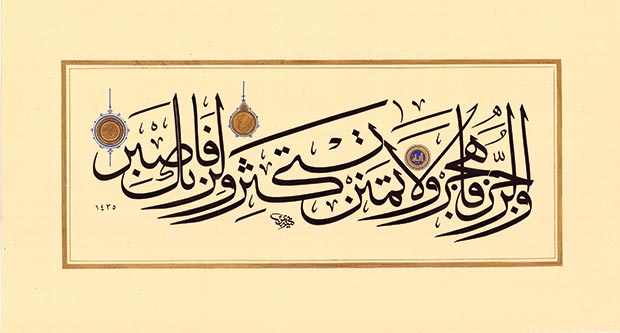 Ayman Hassan, calligraphy / Courtesy of the Artist
Ayman Hassan, calligraphy / Courtesy of the Artist
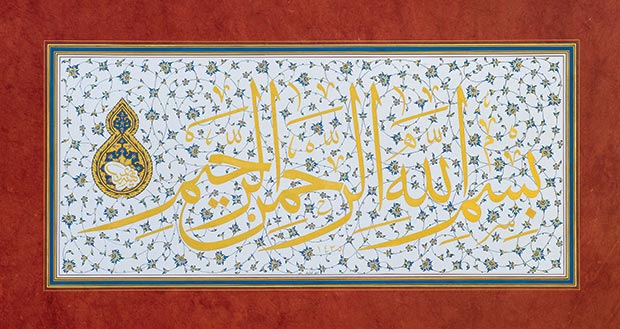 Ayman Hassan, calligraphy / Courtesy of the Artist
Ayman Hassan, calligraphy / Courtesy of the Artist
 Ayman Hassan, calligraphy / Courtesy of the Artist
Ayman Hassan, calligraphy / Courtesy of the Artist
It is so hard to speak about what today's audience expectation. Because we live in time when the boundaries of cultures and thoughts are so invisible and change all the time as communications technology develops. 150 years ago, one couldn't encounter music from beyond his region in the Muslim world and even in the most of the world; nowadays one can listen to music from all over the world. Therefore today's audience is very diverse in what they want and love. Sometimes they are confused I dare to say. From personal experience, in many places in the Muslim world this confusion comes from the conflict between the implicit appreciation of the long artistic heritage of Islamic art with the will of progression and development inspired by the modernism. This is not limited to the audience; calligraphers are facing the same inner conflict as well, even though many of them are not aware of that. This differs also from community to another. This diversity is challenging calligrapher in terms of what approach s/he shall take in addressing the audience's expectations; if the calligrapher is ever to meet the expectations rather than to do what s/he thinks the best without paying attention to audience.
When I visit a calligraphy exhibition, and as a member of "today's audience" I notice that many of today's calligraphers are not working to satisfy the audience not even their own artistic passion. Since the mastery of classical Islamic calligraphy is proven through winning in calligraphy competitions, I noticed that many of these calligraphers are still writing – subconsciously - to satisfy the jury members not the audience and not even to satisfy themselves, which I claim has a really negative effect on the development of this art altogether. If we took the trends of today's calligraphers, we can trace the effect of competitions on their creative approach to calligraphy. When IRCICA's contest was the only major international contest the circular jaly-thuluth composition was the trend. Then comes Alburda contest in Abu Dhabi and we started to see more interest among the calligraphers in thuluth - naskh qit'as, and when Mr. Muhammad Chebi launched his competition for Hilye we could see the preferences of his own taste and the jury's taste not only in the works written for the competition but also those written after that. I'm not against all of this, but I just want today's calligraphers to be more original and less conservative about their own taste and to express themselves boldly.
Regarding the approach that must be taken to develop Islamic calligraphy, I'm open to the two approaches. I tend to evaluate each experience separately. But I think the tendency of braking rules does not guarantee a beautiful outcomes, what is guarantees is only different outcome. My criterion in this matter is the Hadith that says: "This who believes in Allah and judgement day shall say good things or be silent". If calligrapher is going to break the rules to create something that is beautiful and touching then it is acceptable; but if it is only to have something that differentiates them from the others then it is nothing but ego.
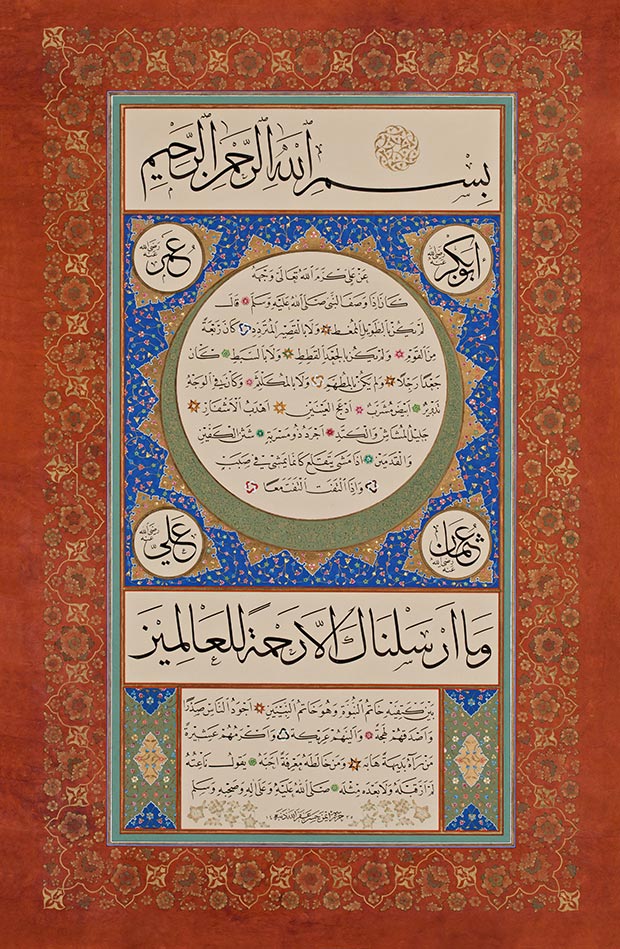 Ayman Hassan, calligraphy / Courtesy of the Artist
Ayman Hassan, calligraphy / Courtesy of the Artist
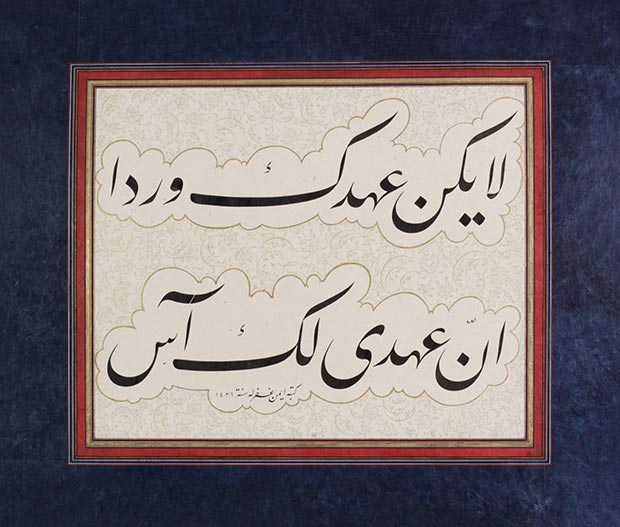 Ayman Hassan, calligraphy / Courtesy of the Artist
Ayman Hassan, calligraphy / Courtesy of the Artist
It would be an act of ingratitude if I deny the efficiency of meÅŸk system, for I studied myself in this way. However, this system is an outcome of a society that has lived ages before and it is by no mean comparable with the society in which we live today. Those days' masters did their best and I think today's master calligraphers must but more effort in developing teaching methods to make it easier for today's students who are not as patient as their grandparents, and have less time to spend on learning anything outside official education system. I believe there is a lot that can be made in this regard and masters of today must be up to their responsibility.
I live and practice in Kuwait and had the chance to participate in many exhibitions regionally and internationally. In general, the last decade witnessed a lot of progression. But we still need to promote calligraphy internationally. To do so, there are many things to consider in my opinion. For instance, hanging a work of calligraphy in an art gallery will immediately recall the comparison between art of painting and art of calligraphy. Many people would either evaluate calligraphy as a painting and then they will never get the real essence of it, or they will try to decipher the text, in case they know the language of the text, in this case their relation with the work is done once they read the text. If the audience is directed to shift their paradigm a little to perceive work of Islamic calligraphy as a piece of music or architecture then they would taste it in terms of rhythm, harmony, mass balance and qualities alike; which is a totally different perception of calligraphy. We also must refrain from presenting calligraphy as folklore; something that is authentic, has little to do with today's life, and endangered with extinction.
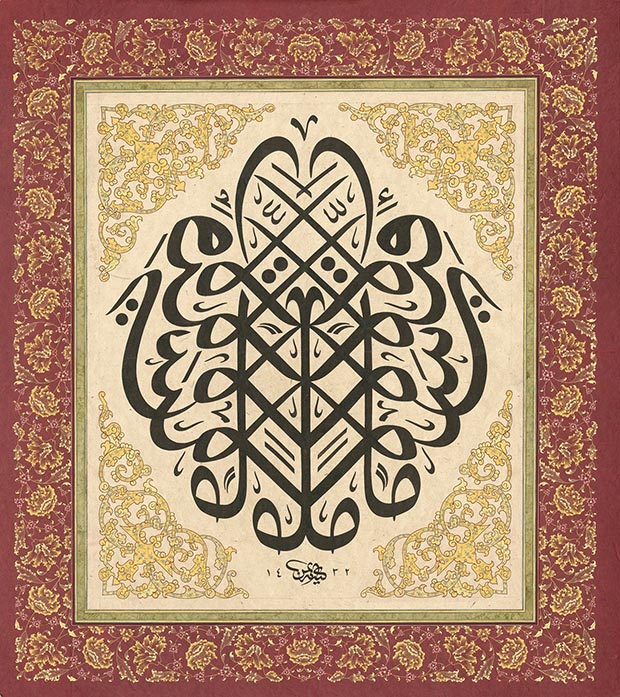 Ayman Hassan, calligraphy / Courtesy of the Artist
Ayman Hassan, calligraphy / Courtesy of the Artist
 Ayman Hassan, calligraphy / Courtesy of the Artist
Ayman Hassan, calligraphy / Courtesy of the Artist
No. This is one of the worst shortfalls Islamic calligraphy is suffering. There are few books about the history of calligraphy many of them are not of best methodology. Most of books are dealing with biographies of calligraphers. They keep on telling us who was born where, but they have too little to say about their practices, their methods, their thoughts and so forth. It is also common to see those "Academic" books that collect artworks by a given calligrapher and describe them. They put a photo of an art work to describe it in terms of script, paper colour, ink colour, number of lines and date of writing - as if the reader is incapable of noticing these things by looking to the work itself. And when it comes to the philosophical studies we can name very few books that can be counted on one hand's fingers. It is therefore difficult to develop this art in a proper way since many practicing calligraphers are incapable even to explain the importance, value, and significance of this art let a side developing it. It is, therefore, up to calligraphers themselves to play the two roles: A) to practice and develop their skills and produce art. B) To be art critics and do their own researches in philosophy and history of art.
Comments
Add a comment
Commenting is not available in this section entry.